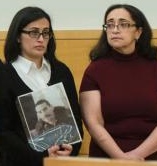 Raymond Mora's wife (holding photo of Mora) and daughter On February 7, 1980, a fire erupted in a three-story Brooklyn townhouse, killing 27-year-old Elizabeth Kinsey and her five children: Two boys, Troy, 9, and Damon, 17 months, and three girls, Tamu, 6, Keya, 4 and Nigene, 9 months.
That same day police arrested three men and charged them with murder and arson: 25-year-old Raymond Mora, 30-year-old Amaury Villalobos , and 34-year-old William Vasquez.
They were charged after the building’s owner, Hannah Quick, said that she argued with one or two of the men over a bad batch of drugs. At the time, Quick was facing charges that she operated a “shooting gallery” in her apartment where people came to get high on heroin.
Mora, Villalobos and Vasquez went to trial in Kings County Supreme Court in November 1981. Quick testified that following the argument, one of the men threatened to return and burn the building down. She told a jury that she was awakened by a noise shortly before the fire broke out and heard the three men whispering in Spanish. When she went back to bed, she looked out her window and saw the three men leave just before an explosion rocked the building. Flames erupted and Kinsey and her children were trapped on the third floor where they perished.
The state fire marshal assigned to investigate the blaze concluded that the fire had started at two separate locations on the first floor and that separate ignition points indicated the fires were started intentionally.
In addition, there were areas of low burning along the baseboards, which the fire marshal said indicated the fires started there. “Fire can’t travel downward. Fire travels up,” he testified. According to the fire marshal, puddle shapes on the tiles—called pour patterns—and the fact that the baseboards had burned down to the ground level indicated an accelerant was used. Laboratory tests found no traces of accelerant in the debris, but the defense lawyers for the three men failed to introduce that evidence at trial.
Mora’s and Villalobos’s wives testified that they were with their husbands at the time the fire broke out. Mora, Vasquez and Villalobos were convicted by the jury on November 24, 1981. They were each sentenced to 25 years to life in prison.
Their appeals were denied. Mora died in prison in 1989. Villalobos and Vasquez—who lost his eyesight in prison because of untreated glaucoma—were released on parole in 2012.
That same year, Villalobos contacted the New York Law School’s Post-Conviction Innocence Clinic where law students and Clinic director Adele Bernhard took on the case. After they were denied records by the New York Fire Department, they persuaded the Appellate Division of the Kings County Supreme Court to order the records released.
The fire records were examined by John Lentini, an arson expert, who concluded that the fire marshal’s determination that there were two separate fires was incorrect. That mistake was based on what was known about fires in 1981.
The marshal’s “interpretation of the fire damage was consistent with what was believed about fire behavior in 1980, but today’s knowledge of fire behavior would dictate a different interpretation,” Lentini said in his report. “Today, investigating fire experts would conclude that greater damage in the front and rear of the first floor was caused by the fact that the bedroom and the foyer had better access to ventilation than did the area in the center of the apartment.”
Lentini said the evidence indicated that “flashover” had occurred. “Flashover” occurs when a room becomes so hot that the entire room catches fire at once and burns with an intense heat. Flashover is most likely in areas with good ventilation. It can leave behind debris that used to be interpreted as suggesting the fires had multiple locations. The “pour patterns” that the marshal relied on have also been discredited as evidence that an accelerant was used. “The errors caused by this particular misinterpretation have been legion,” Lentini said. “Such errors have resulted in numerous wrongful prosecutions and numerous improper denials of insurance proceeds.”
“The science of fire dynamics was poorly understood in 1980, and much of what was believed by well-meaning investigators was, unfortunately, false,” Lentini said in the report. “If today’s standards and knowledge of fire dynamics were applied to this investigation, the results would have been significantly different.”
Relatives of Quick, who died in 2014, were interviewed and said she was a chronic liar who suffered from alcohol and drug abuse. The addicts who came to shoot up heroin often did so by candlelight in a vacant apartment on the first floor of the building. And they said Quick had illegally reconnected the electricity to the building after it was cut off.
In the spring of 2015, Bernhard and her students submitted the results of their investigation to Brooklyn District Attorney Ken Thompson’s Conviction Review Unit. Investigators working under Mark Hale, head of the unit, located Quick’s daughter who said that before Quick died, she admitted she had lied about seeing Mora, Vasquez and Villalobos and that she regretted sending three innocent men to prison. In addition, she had received an insurance settlement after the fire—which she denied during her trial testimony.
On December 16, Villalobos and Vasquez were back in Kings County Supreme Court where their convictions—and Mora’s—were vacated and the charges were dismissed. In March 2017, Villalobos and Vasquez settled compensation claims against the city and state of New York for a total of $30.9 million. A claim filed by Mora's family against the city was settled for $1 million, and a separate claim against the state was settled for $400,000.
– Maurice Possley
|